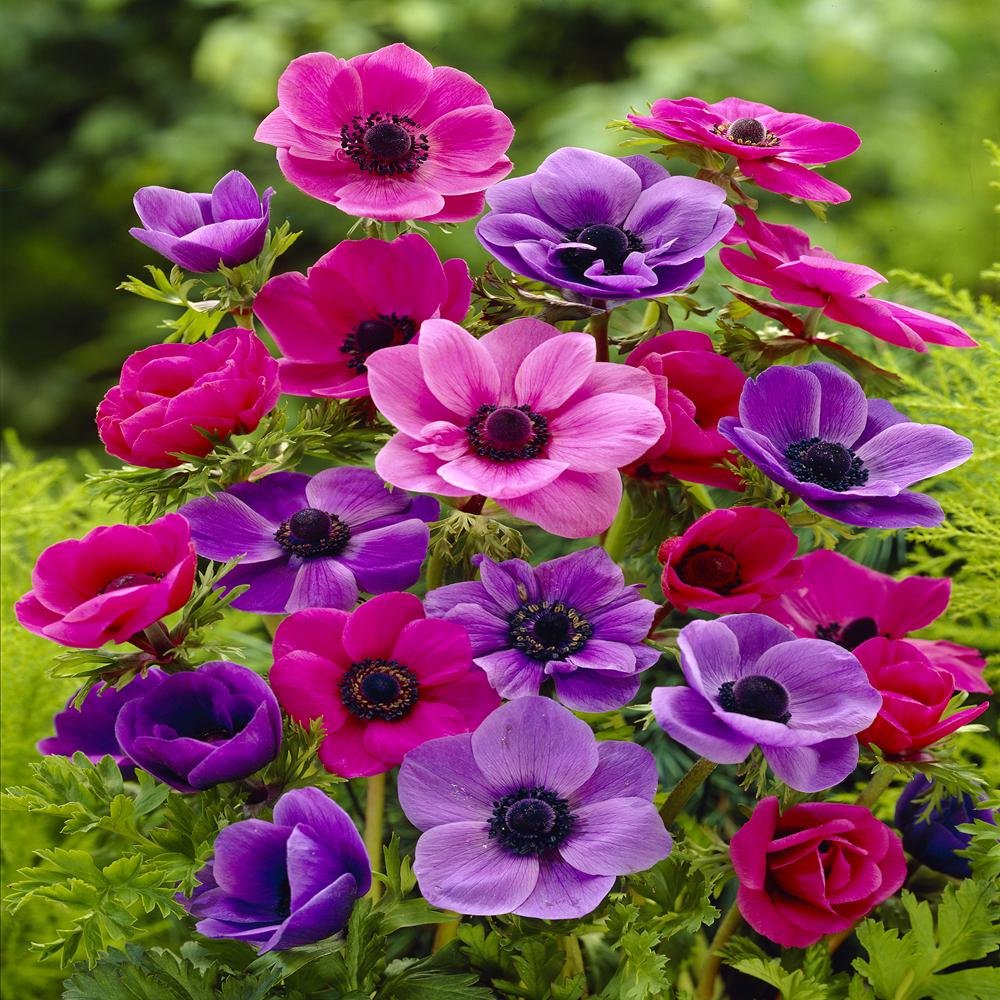With their windswept grace and vivid petals, Anemones bring movement and charm to any garden. Often called “windflowers,” they come in many varieties—from early-blooming woodland types to late-season showstoppers with jewel-toned blooms.
Despite their delicate appearance, many Anemones are surprisingly resilient, spreading gently and filling garden gaps with seasonal elegance. Whether you’re planting for spring delight or fall drama, there’s an Anemone for nearly every zone and style.

Portrait of the Anemone
Belonging to the buttercup family (Ranunculaceae), Anemones include over 100 species, offering a wide range of forms, bloom times, and habits. Popular types include Anemone coronaria (poppy-like, late spring), Anemone blanda (early spring), and Anemone hupehensis (fall-blooming).
- Type: Herbaceous perennial
- Family: Ranunculaceae
- Common Names: Windflower, Anemone
Foliage and Form
Anemones grow with a light, graceful habit, often forming clumps. Their leaves are deeply divided, fern-like, and sometimes fuzzy, depending on the variety.
- Height: 15–90 cm (6–36 in)
- Spread: 20–60 cm (8–24 in)
- Growth Habit: Upright or spreading, often forming colonies
Blooms and Fragrance
Anemone flowers vary in appearance, from simple poppy-like blooms to semi-double and double forms. Their color palette spans whites, pinks, purples, reds, and blues, often with contrasting centers.
- Bloom Time:
- Spring: Anemone blanda, Anemone nemorosa
- Summer–Fall: Anemone hupehensis, Anemone hybrida
- Color: White, pink, red, blue, purple
- Fragrance: Generally minimal
The Right Time to Plant, Prune, and Enjoy Anemone
| Month | Planting | Flowering | Pruning |
|---|---|---|---|
| January | ❌ | ❌ | ✅ Cut back old stems |
| February | ✅ Tuber planting indoors | ❌ | ✅ Remove dead foliage |
| March | ✅ Plant tubers outdoors | ✅ Early types (blanda) | ✅ Tidy up stems |
| April | ✅ Transplants, divisions | ✅ Spring bloom continues | ✅ Light grooming |
| May | ✅ Plant coronaria for summer | ✅ Late spring (coronaria) | ❌ |
| June | ❌ | ✅ Peak for coronaria | ❌ |
| July | ❌ | ✅ (early hupehensis) | ❌ |
| August | ✅ Plant fall-blooming types | ✅ Fall bloom starts | ❌ |
| September | ❌ | ✅ Peak bloom (fall types) | ✅ Deadhead to prolong bloom |
| October | ✅ Fall division of clumps | ✅ (mild climates) | ✅ Cut back faded flowers |
| November | ❌ | ❌ | ✅ Prepare for dormancy |
| December | ❌ | ❌ | ✅ Mulch for winter protection |
✅ = Recommended ❌ = Not advised
Watering, Sunlight, and Environment for Anemone
Watering
Anemones enjoy consistent moisture, especially when actively growing and blooming. However, they dislike soggy soils—particularly in winter.
When to Water: Weekly during growth and bloom
How Much: Keep soil evenly moist
Watch for: Wilting or yellowing from drought or rot
Sunlight
Different species have slightly different light needs:
- Spring types (blanda, nemorosa): Part shade or dappled woodland sun
- Fall types (hupehensis): Full sun to part shade
Rule of Thumb: Morning sun, afternoon shade works for most
Indoor vs Outdoor
Anemones are best suited for outdoor gardens, especially in beds, borders, and woodland settings. Indoor culture is not common, except for Anemone coronaria as cut flowers.
Outdoor Best Use: Mixed borders, shade gardens, naturalized settings
Indoor Use: Cut flower arrangements only
Temperature
Most species tolerate cold and even snow (spring types), while others prefer mild summers and cool falls.
Optimal Range: 10–22°C (50–72°F)
Hardiness Zones: USDA 4–9 (check specific species)
Protection Tip: Mulch fall-bloomers to overwinter in cooler zones
Ideal Soil Conditions for Growing Anemone
| Soil Feature | Optimal Condition | Why It Matters |
|---|---|---|
| Soil Type | Rich loam or compost-amended soil | Encourages strong roots and blooms |
| Texture | Loose, well-aerated | Prevents compaction and rot |
| Drainage | Well-draining | Essential for tuber health |
| Moisture | Evenly moist during growth | Avoids drying out or waterlogging |
| Soil pH | Slightly acidic to neutral (6.0–7.0) | Balances nutrient availability |
| Fertility | Moderate, organic matter-rich | Supports foliage and flowering |
💡 Tip: Soak tubers overnight before planting to speed up sprouting.
Common Problems & Solutions
| Issue 🐾 | Symptoms 🔍 | Solutions 🛠️ |
|---|---|---|
| No Blooms 🌱 | Lots of leaves, no flowers | Needs more light or older tubers |
| Powdery Mildew 🍃 | White coating on leaves | Increase airflow, avoid wetting leaves |
| Rotting Tubers 💧 | Mushy, smelly, fail to sprout | Improve drainage, avoid overwatering |
| Leaf Scorch ☀️ | Brown, crisp edges | Too much direct sun or dry soil |
| Slugs/Snails 🐌 | Ragged leaves, slimy trails | Hand-pick, use slug traps |
With their ethereal petals and effortless motion in the breeze, Anemones lend poetry to any garden space. Whether you’re planting springtime carpets beneath trees or weaving fall varieties through sunlit borders, these timeless bloomers reward you with delicacy and resilience in perfect balance.